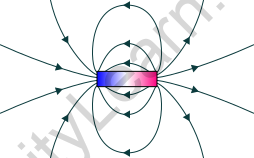Table of Contents
Introduction:
Magnetic field: The magnetic field is the space around a magnet where the magnet’s force may be measured. The magnetic field is a quantity with both magnitude and direction. It’s a quantity with a vector. It resembles the electric field that surrounds a charge. Even when they are a certain considerable distance from a magnet, little bits of iron are attracted to it.
This indicates that magnetic forces, like electrical and gravitational forces, act at a distance. The entire space around the magnet is surrounded by a magnetic field. An electric current or magnetic dipole generates a magnetic field, which exerts magnetic forces on other particles in the vicinity. When a magnet interacts with a magnetic field formed by another, it exerts force.
A brief note
Magnetic field lines, often known as force lines, are imaginary lines used to depict the magnetic field. Michael Faraday was the one who brought it up. For a field’s graphical depiction. When an iron filings design is dispersed equally over a magnet on cardboard, the iron filings appear to arrange themselves in the pattern displayed.
The iron fillings operate like miniature magnets that are subjected to a force owing to the magnet’s magnetic field. Magnetic field lines always start at the magnet’s N-pole and conclude at the magnet’s S-pole. The magnetic field lines represent the path taken by an isolated unit north pole in the field.
The magnetic field lines depart the north pole of a magnet and approach its south pole to trace the Magnetic Field Pattern owing to a bar magnet using a compass. The extent of the closeness of the field lines indicates the field strength. As a result, in which the field lines are closer together, the magnetic field is the greatest.
Important concepts
Magnetic lines of force are lines that indicate the magnetic force present in the magnet’s environment.
Magnetic lines of force have the following qualities.
- Magnetic field lines extend from the north pole to the south pole and then unite.
- The density of magnetic lines diminishes as the distance between poles grows.
- The inside of the magnet’s field lines run from the South Pole to the North Pole.
- Magnetic lines need not cross over one another.
- The magnetic lines’ intensity stays unchanged continuously and is proportionate to their proximity.
The force lines:
A line of force is a specific line/path followed by an electric charge that can readily move in an electric field, a mass that can freely move in an earth gravitational field, or any other acceptable test particle in a given force field. The line force is always represented by a vector field, V = – grad ϕ, and also, because a potential ϕ always travels normally to the equipotential area of surfaces, the changes in its travelling direction will be represented by continuous lines drawn in a similar manner. The line of force is the line and the individual force operating on it.
A solenoid is a lengthy coil of wire with several turns wrapped around it. It creates a virtually homogeneous magnetic field inside when a current runs through it. Solenoids are widely employed as switches because they can transfer electric current to mechanical action. The current and density of spins in a solenoid determine the magnetic field. The change in magnetic field energy when the rod is introduced into the solenoid can be used to determine precisely the force at which a solenoid draws on ferromagnetic rods positioned near it.
The magnetic field’s energy density is determined by the field’s squared strength as well as the magnetic permeability of the substance it occupies. Iron has a substantially higher permeability than steel.
Magnetic flux lines are essential for a variety of reasons:
- Magnetic field lines are indeed the lines in a magnetism whose tangent indicates the field direction at any given position and whose density gives the field magnitude.
- They indicate the magnetic field’s direction.
- The amount of magnetic field lines determines the intensity of the magnetic field. Since the lines are greater near the poles, the magnetic field is stronger there.
- The frequency of a magnetic field is proportional to the number of magnetic field lines present in a given area.

Magnetic fields could be observed using magnetic field lines, which have the following properties:
The magnetic field line is parallel to the field. The line density is related to the field strength. Field lines are not allowed to cross. Field lines are loops that continue indefinitely. These are closed, continuous curves that begin at the N-pole and end at the S-pole before returning to the N-pole through the magnet’s interior. Near the poles of a magnet, magnetic field lines are closer together, while they are widely spaced elsewhere. As a result, magnetic field lines are dense at the pole, where the field is strong, and sparse near the magnet, where the field is faint. Magnetic field lines that are parallel and equidistant represent a homogenous magnetic field, similar to the Earth’s magnetic field. There can be no crossing of magnetic lines of force. If they cross, it means there are two magnetic field directions at that location.
Significance of magnetic field lines in NEET exam:
The NEET ponderings in magnetic field lines are supposed to reveal and respond to the test’s most frequently asked questions. These can be elucidated in simple terms with the use of notes from experienced researchers in the subject, which are available on the Infinity Learn online stage. Many decision questions are clear to rehearse assuming that understudies maintain a thorough understanding of the themes throughout the training program. How much do important NEET questions assist understudies in planning for a long period of time inquiries, which are prevalent in the crucial test.
Also read: The Magnetic Dipole Moment of a Revolving Electron
Frequently asked questions (FAQs):
Question 1: Define the density of magnetic flux.
Answer: The amount of magnetic flux in a region measured perpendicular to the magnetic flux’s direction is known as magnetic flux density. It is designated by the letter B and is measured in Tesla units.
Question 2: Define the strength of the magnetic field.
Answer: The Magnetic Field Intensity or Magnetic Field Strength is a ratio of the MMF required to produce a specific Flux Density (B) within a material per unit length of that material.
Question 3: Is it genuine that there are attractive fields in space?
Answer: Attractive fields exist in space, yes. Based on examinations of an immense number of pulsars and the polarization of their radio waves, the twisting arms of the Milky Way seem to have some exceptionally enormous scope coordinated attractive field. Attractive fields have been found in interstellar residue mists. The fields are increased when the mists break down.






